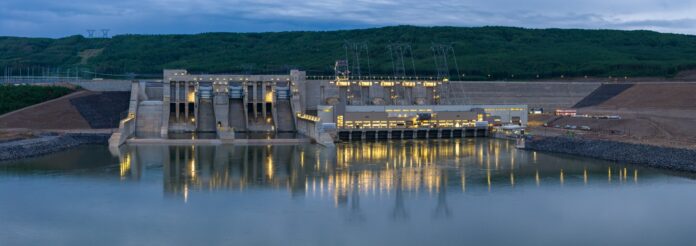After a decade-long project, Site C reached its full operational capacity as the final generating unit officially came to service.
B.C. Hydro made the milestone announcement on the morning of August 9, when Site C’s sixth generator was successfully commissioned, meaning it was approved and its turbines were deemed to be effectively converting energy into electricity.
The site will now create, “enough energy to reliably power about 500,000 homes annually. The project increases B.C. Hydro’s total electricity supply by about eight per cent,” according to the utility company.
Site C is located about 12 kilometres outside of Fort St John – construction began in 2015 and the first hydroelectric generator came online nine years later, in October 2024. In the subsequent months, all six generators got to work, with the final power convertor being fully commissioned on Saturday.
The Peace River Regional District said they received $426,229.51 from the hydroelectric dam’s first period of operations in 2024, from October 28 to December 31 – these funds were allocated among the various cities in the region based on their formula, which considers population, among other factors.
According to the district’s letter to the communities who reside within their boundaries, the city of Fort St John received the largest portion, at $158,627.07.
$53,606 of the regional district’s funds went to Dawson Creek – and the remainder of the funds were distributed to Chetwynd, the district of Taylor, and various other communities in the Peace.
“Going forward, the Peace River Regional district will receive $2.4 million plus an adjustment by the B.C. Consumer Price Index annually, and will disburse the municipalities’ portion each fall,” said the district in their letter.
This final generator’s successful commissioning, B.C. Hydro said, is a moment of pride for the company.
“Site C represents years of dedication, innovation, collaboration and overcoming challenges. Now that Site C is in full operation, it will serve our customers for the next 100 years and play a critical role in ensuring a stable and reliable electricity system,” said Charlotte Mitha, the president and CEO at B.C. Hydro.
Despite this landmark moment at the dam, work at the site is not over yet, according to B.C. Hydro, who said they must finish construction on other areas, including the powerhouse and the surrounding access roads.
Members of the public are cautioned to keep their distance from the reservoir as work continues. B.C. Hydro’s public boat is expected to launch next spring, at the earliest, they said the boat can only be launched when the area is safe for non-crew members to access.






